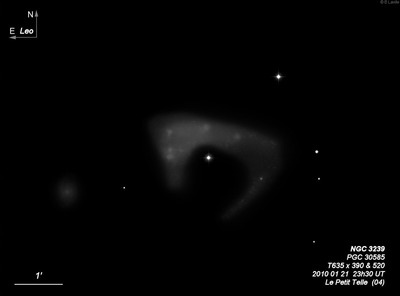
William Herschel discovered NGC 3239 = H IV-10 = h710 = h3246 on 21 Mar 1784 (sweep 181)and recorded "A pretty considerable star, with a milky vF brush after it. The position of the brush is about 15 or 20° nf. With 240 I saw 2 vF stars towards the confines of the brush; but they seemed to have no connection with it. The bright star is the following one of a triangle, the preceding stars of which are a little smaller. It precedes a large star 3 1/2 min of time and is 2' more north." His description and position applies to Arp 263 = VV 95.
10 observations were made at Birr Castle, with knots in NGC 3239 mentioned several times. On 10 Jan 1856, R.J. Mitchell commented "A knot north of the star and another nff, the space between them and the star is filled with faint mottled nebulosity. A star suspected in np end of the following knot. A very faint nebula suspected following?". The last comment probably refers to CGCG 094-042, which is 3' ESE.
On the POSS, the bright knot on the southeast end seems like it could be an interacting galaxy but on the SDSS it looks like a large, blue HII region. Also the area immediately north seems dusty. Contains unusual asymmetric arcs to the south as if very disturbed. This galaxy has a listed redshift of only 0.0025, while the surrounding galaxies (6 viewed on 3/28/09) have a redshift of z = .044.
400/500mm - 17.5" (4/13/91): fairly faint, moderately large, elongated 2:1 E-W, very unusual appearance as a mag 9 star (BD+17 2217) is superimposed on the south side. An unusually bright knot is following the bright star by 51" on the SE side of the galaxy. This is possibly an offset nucleus or more likely an HII knot. The galaxy appears to extend to the west from this knot. The galaxy exhibits an irregular surface brightness with edges difficult to define as it fades into the background. The halo is more extensive to the north with averted vision. About 2' NW and 2' W are two mag 11 and 12 stars.
900/1200mm - 48" (5/4/16): NGC 3239 was examined at 488x, specifically looking for the two tidal tails not seen in the previous observation with Lowrey's 48". A very faint curving tail or hook (identified as "Tail A" in Krienke & Hodge's 1990 paper "The structure of the irregular galaxy, NGC 3239") was seen extending from the very bright HII knot (VV 95b) on the southeast side. It curves clockwise to the southeast in the direction of a mag 15.8 star [2' ESE of the mag 10 superimposed star].
Beyond the west end of the main glow is a fairly wide, very low surface brightness glow (the start of "Tail B") in the direction of a mag 12.5 star (2.4' due W of the bright star); it then sweeps broadly towards the south. A narrow extension heading southwest ends at a faint HII knot, perhaps 6" diameter, which is identified in NED as NGC 3239:[HK83] 75 and 80.
48" (2/19/12): NGC 3239 = Arp 263 is a large, disrupted irregular, dominated by numerous HII regions. It was a fascinating sight at 488x. A mag 10 star is superimposed on the southwest side of the galaxy with the patchy, highly irregular surface brightness glow of the galaxy extending mainly north and east of the star.
A very bright, round knot of ~15" diameter is prominent on the southeast side of the galaxy. This HII complex is catalogued as VV 95b in NED and as region #6 and #10 in Hodge-Kennicutt's 1983 "An Atlas of HII Regions in 125 Galaxies". A faint star or knot is attached on the north side. A "star" recorded just off the west side of this knot turns out to be supernova SN 2012A, discovered on 7 Jan 2012, still currently around 14th magnitude (see image at http://skycenter.arizona.edu/gallery/Galaxies/ngc3239). Very faint haze extends southeast of VV 95b, but the "tail" structure was not seen.
Along the north side of the galaxy (elongated east-west) are several additional knots. About 30" due north of VV 95B is HK[83] #3 and #4. This close pair of knots appeared as a faint, small, irregular glow, ~6" diameter. Patchy haze is just west, but with no condensed spots. Further west, and 40" due north of the mag 10 star, is a moderately bright, small, round knot, ~10" diameter that has several HK[83] entries (#28/29/31/34). To the west of this knot, the glow of the galaxy ends near HK[83] #57/58, a faint low surface brightness knot that is elongated N-S.
Notes by Steve Gottlieb